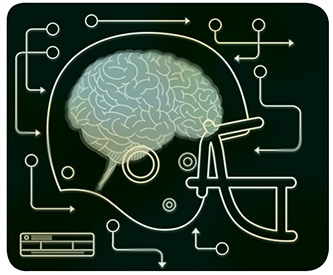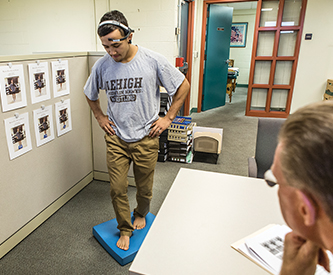Seeking Clarity on Concussions

While the tragic consequences of multiple concussions to professional athletes make headlines, college athletes and those much younger face risks, too
Lehigh student-athletes are participating in clinical studies of brain wave activity to help develop technology that takes the guesswork out of diagnosing concussions and determining when injured athletes should return to play.
Jack Foley, associate director of athletics for sports medicine at Lehigh, is helping conduct the studies in collaboration with Cerora Inc., based at Ben Franklin TechVentures on the Mountaintop Campus. The company’s Cerora Borealis™, a portable device that can be worn as a headset or on Google Glass, measures brain waves and communicates with a computer to record data.
The platform would allow athletic trainers and other medical professionals to gather objective diagnostic data near the playing field for assessments. Athletic trainers now rely on subjective markers, such as a graded symptom checklist and field exams that test memory and balance, to evaluate possible concussions.
“The real aim here is to protect athletes and protect their future,” said Adam Simon, Cerora’s president and chief executive officer. Noting that the long-term risks of multiple concussions include cognitive impairment, dementia and depression, Simon said he believes the technology could help reduce the deleterious aspects of collision-prone sports.
More than 250 Lehigh student-athletes, including 47 who suffered concussions, have volunteered in the last three years to participate in the studies, in which athletes’ cognitive functions and postural stability are tested. Cerora hopes to have FDA clearance by the end of 2015 for use of the medical device as a brain-wave monitoring tool.
While the tragic consequences of multiple concussions to professional athletes make headlines, college athletes and those much younger face risks, too. The Centers for Disease Control estimates that 248,418 people ages 19 or younger were treated in U.S. emergency rooms in 2009 for sports and recreation-related injuries that included a diagnosis of concussion or traumatic brain injury.
“We’re trying to build a high sensitivity technology or tool to allow an invisible injury to all of a sudden become visible," Simon said.
Concussion management was already a priority for Foley and Lehigh University Sports Medicine when Cerora reached out in 2011 about its developing technology. In 1999, the university had been selected to participate in inaugural NCAA clinical studies with noted researchers about the cumulative effects of concussions. And in 2003, Lehigh rolled out its Concussion Management Plan involving a graded symptom checklist and cognitive and balance testing. (It’s been revised three times.) Questions most often raised in developing the plan revolved around return-to-play decisions., Foley said.
With the university’s introduction to Cerora feeling like fate, Foley weighed what the technology could mean to clinicians and athletes. He considered: “What if we could offer a functional application to definitely determine when it is safe and appropriate to return to play without always relying on subjective information as symptoms alone or driven by a timeline?”
As part of the studies, Lehigh student-athletes, including those who participate in football and wrestling and women’s soccer, lacrosse and basketball, receive several brain scans that include baseline and post-concussion screenings with a control subject of the same sport and age performing identical scans. Potential newcomers will be men’s lacrosse, women’s field hockey and volleyball. Athletes in all intercollegiate sports who have suffered concussions in their sports also are followed during the post-concussion phase. Participation is voluntary.
The goal is to establish an EEG (electroencephalography) signature of healthy student-athletes for comparative use with those who suffered concussions, and to look for trends over a competitive season.
Since concussions are not always clearcut, the company hopes to empower field clinicians with an ensemble of tools and biosensors engineered for ease of use. Brain data would be wirelessly transmitted to a central “cloud” computer that rapidly scans for biomarkers within the data. “Our idea is to collect all the data, encrypt it, move it to the cloud, analyze it in the cloud, produce a report and bring that back to [field clinicians] in one minute...,” Simon said. “We’re trying to empower field clinicians. We don’t want to ever replace them.”
Mayuresh Kothare, the department chair and R.L. McCann Professor of Chemical Engineering at Lehigh, is a principal investigator in the collaborative research program.
Posted on:


